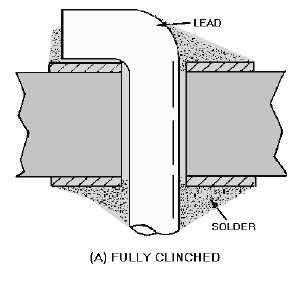3-9
As you can see, the flat-set eyelet actually provides reinforcement for the pads on both sides of the
circuit board and reinforces the hole itself. The design of the roll-set eyelet (which may trap gasses, flux,
or other contaminants, and obscures view of the finished solder flow) is not acceptable as a repair
technique. The funnel-set eyelet does not provide as much pad reinforcement as the other types. However,
it provides better "outgassing" of flux, moisture, or solvents from the space between the eyelet and the
hole wall. It also provides a better view of the finished solder connection than the roll-set eyelet.
Lead Terminations
The finished circuit board consists of conductive paths, pads, and drilled holes with components
and/or wires assembled directly to it. Leads and wires may terminate in three ways: (1) through the hole
in the board, (2) above the surface of the board, or (3) on the surface of the board.
THROUGH-HOLE TERMINATION.—This style provides extra support for the circuit pads, the
hole, and the lead by a continuous solder connection from one side of the circuit board to the other. Three
basic variations of through-hole termination are the CLINCHED LEAD (two types), STRAIGHT-
THROUGH LEAD, and OFFSET PAD.
Clinched Lead.—The clinched-lead termination is usually used with unsupported holes, but is found
with supported holes as well. Both clinched-lead types, FULLY CLINCHED and SEMICLINCHED
(figure 3-5), provide component stability. Like the fully clinched lead, the semi-clinched lead also
provides stability during assembly. However, this termination can be easily straightened to allow removal
of the solder joint should rework or repair be required. Note that the fully clinched lead is bent 90 degrees
while the semiclinched lead is bent 45 degrees.
Figure 3-5A.—Clinched leads. FULLY CLINCHED.



